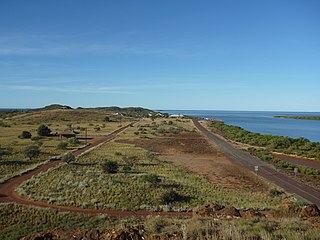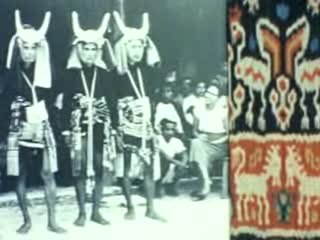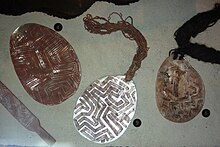
Indigenous Australian art includes art made by Aboriginal Australians and Torres Strait Islanders, including collaborations with others. It includes works in a wide range of media including painting on leaves, bark painting, wood carving, rock carving, watercolour painting, sculpting, ceremonial clothing and sandpainting; art by Indigenous Australians that pre-dates European colonisation by thousands of years, up to the present day.

Cossack, known as Bajinhurrba in Ngarluma language, and formerly known as Tien Tsin, is an historic ghost town located 1,480 km (920 mi) north of Perth and 15 km (9.3 mi) from Roebourne in the Pilbara region of Western Australia. The nearest town to Cossack, which is located on Butcher Inlet at the mouth of the Harding River, is Wickham. The former Tien Tsin Harbour is now known as Port Walcott. Since 2021, the townsite is managed and operated by the Ngarluma and Yindjibarndi Foundation Ltd (NYFL).

Bark painting is an Australian Aboriginal art form, involving painting on the interior of a strip of tree bark. This is a continuing form of artistic expression in Arnhem Land and other regions in the Top End of Australia, including parts of the Kimberley region of Western Australia. Traditionally, bark paintings were produced for instructional and ceremonial purposes and were transient objects. Today, they are keenly sought after by collectors and public arts institutions.

Henry Gibson Dan, known as Seaman Dan, was an award-winning Torres Strait Islander singer-songwriter with a national and international reputation. His first recording, an album called Follow the Sun, was released in 2000, on his 70th birthday.

Australian Aboriginal artefacts include a variety of cultural artefacts used by Aboriginal Australians. Most Aboriginal artefacts were multi-purpose and could be used for a variety of different occupations. Spears, clubs, boomerangs and shields were used generally as weapons for hunting and in warfare. Watercraft technology artefacts in the form of dugout and bark canoes were used for transport and for fishing. Stone artefacts include cutting tools and grinding stones to hunt and make food. Coolamons and carriers such as dillybags, allowed Aboriginal peoples to carry water, food and cradle babies. Message sticks were used for communication, and ornamental artefacts for decorative and ceremonial purposes. Aboriginal children’s toys were used to both entertain and educate.
Papunya Tula, registered as Papunya Tula Artists Pty Ltd, is an artist cooperative formed in 1972 in Papunya, Northern Territory, owned and operated by Aboriginal people from the Western Desert of Australia. The group is known for its innovative work with the Western Desert Art Movement, popularly referred to as "dot painting". Credited with bringing contemporary Aboriginal art to world attention, its artists inspired many other Australian Aboriginal artists and styles.

Pearling in Western Australia includes the harvesting and farming of both pearls and pearl shells along the north-western coast of Western Australia.
Beagle Bay is a medium-sized Aboriginal community on the western side of the Dampier Peninsula, north of Broome in the Kimberley region of Western Australia. Beagle Bay was named in 1838 by John Clements Wickham, captain of HMS Beagle

The Dampier Peninsula is a peninsula located north of Broome and Roebuck Bay in the Kimberley region of Western Australia. It is surrounded by the Indian Ocean to the west and north, and King Sound to the east. It is named after the mariner and explorer William Dampier who visited it. The northernmost part of the peninsula is Cape Leveque. It is sparsely inhabited, mostly by Indigenous Australian peoples, some of whom have been granted native title rights to some of their traditional lands. There are many coastal inlets, bays and other features, including Beagle Bay on its western side.
Australian Aboriginal fibrecraft refers to the various ways Aboriginal Australians create fibres traditionally. Materials used depend on where the people live in Australia.
Djarindjin is a medium-sized Aboriginal community located 170 km (110 mi) north of Broome in the Kimberley region of Western Australia, within the Shire of Broome. It is within the traditional lands of the Bardi and Jawi peoples.

Balinese textiles are reflective of the historical traditions of Bali, Indonesia. Bali has been historically linked to the major courts of Java before the 10th century; and following the defeat of the Majapahit kingdom, many of the Javanese aristocracy fled to Bali and the traditions were continued. Bali therefore may be seen as a repository not only of its own arts but those of Java in the pre-Islamic 15th century. Any attempt to definitively describe Balinese textiles and their use is doomed to be incomplete. The use of textile is a living tradition and so is in constant change. It will also vary from one district to another. For the most part old cloth are not venerated for their age. New is much better. In the tropics cloth rapidly deteriorates and so virtue is generated by replacing them.
Jimmy Pike (c1940-2002) was a Walmatjarri Aboriginal artist.

The textiles of Sumba, an island in eastern Indonesia, represent the means by which the present generation passes on its messages to future generations. Sumbanese textiles are deeply personal; they follow a distinct systematic form but also show the individuality of the weavers and the villages where they are produced. Internationally, Sumbanese textiles are collected as examples of textile designs of the highest quality and are found in major museums around the world, as well as in the homes of collectors.
Hector Tjupuru Burton was an Australian Aboriginal artist. He is a leading artist from Amaṯa, in north-western South Australia. His work has been shown in exhibitions since 2003, in several cities in Australia and other countries. His first solo exhibition was held in 2004 in Melbourne. Examples of his paintings are held in the National Gallery of Victoria, the Art Gallery of South Australia, the Art Gallery of New South Wales, and Flinders University.
Joe Nangan (1900-1989) was an Aboriginal Australian lawman, jalngunguru and artist. In his role as a custodian of legends, Nangan was responsible for the preservation of the sounds and performances of ceremonial dance and songlines. As an artist, he created hundreds of pencil and watercolour drawings, as well as incised pearl shells and boab nuts, that convey powerful connections to his Country.
Maringka Baker is an Aboriginal artist from central Australia. She lives in the Pitjantjatjara community of Kaṉpi, South Australia, and paints for Tjungu Palya, based in nearby Nyapaṟi.Maringka is known for her paintings. Maringka paints sacred stories from her family's Dreaming (spirituality). As well as the important cultural meanings they carry, her paintings are known for being rich in colour and contrast. She often paints the desert landscape in bright green colours, and contrasts it against reds and ochres to depict landforms. She also uses layers of contrasting colours to show the detail of the desert in full bloom.
The Girramay are an Australian Aboriginal tribe of northern Queensland.

The Bardi people, also spelt Baada or Baardi and other variations, are an Aboriginal Australian people, living north of Broome and inhabiting parts of the Dampier Peninsula in the Kimberley region of Western Australia. They are ethnically close to the Jawi people, and several organisations refer to the Bardi Jawi grouping, such as the Bardi Jawi Niimidiman Aboriginal Corporation Registered Native Title Body (RNTBC) and the Bardi Jawi Rangers.
Pedro Wonaeamirri is a contemporary Aboriginal Australian painter, carver, printmaker, singer, dancer, and performer. As a member of the Tiwi people, Wonaeamirri regards his art as both a continuation of Tiwi culture as well as an open-ended exploration of style and technique.










